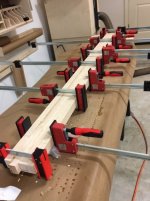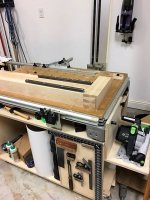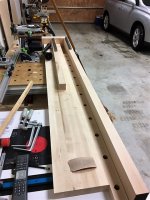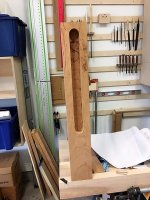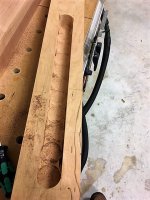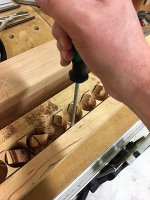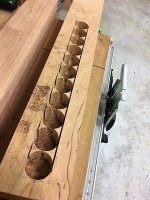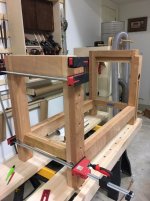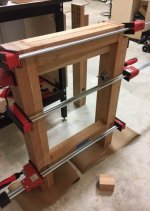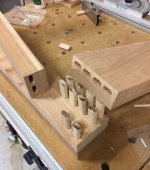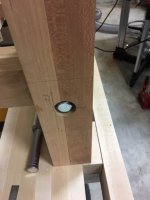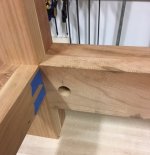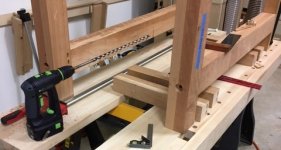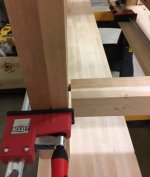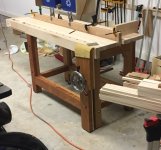Mismarked
Member
- Joined
- Oct 8, 2014
- Messages
- 139
The "Split-Top Rubio" will, of course, be a petite Roubo hybrid (an affectionate, descriptive term, not a political statement).
Inspired by Edward Reno's hybrid workbench post, I went with a 1.5 inch top and both of the benchcrafted vises. It will be about 6' long. Here is the current state of affairs.
[attachimg=4]
[attachimg=5]
[attachimg=6]
As seen in the last photo, I am about ready to make and glue up the dog hole strip before trying to tackle the "condor tails" and end cap. I assume/think the benchtop is too thin for square dogs, and I am trying to choose between 20mm and 3/4" (or maybe re-think the square holes if that is preferable and doable with a 1.5" top).
In Guido Henn's article on the Roubohttps://www.fine-tools.com/pdf/roubo-hobelbank-bauplan-en.pdf (at p. 28), he opted for "the standard 19mm round holes," saying that there was much more hardware available. I understand that the holdfasts are mostly 3/4" as well.
On the other hand, I already have the MFT, Festool low profile clamps, some Quas and Precision dogs and will hopefully be getting some Parf stuff soon. So maybe that route would be more cohesive, and just have a few 3/4" holes for the holdfasts.
Would be interested in any comments on which direction to go. As mentioned in a previous post, I don't have experience with a tail vise, or for that matter any dog holes other than the ones on the MFT.
Also, if I am going to drill round holes on the drill press with a Forstner, should I go with a 3/4" bit for a 3/4" dog (or 20mm bit for 20mm dogs), or something slightly larger.
Lastly, if I go with round holes, should I try to put a slight chamfer in the top of the hole (how would one even do that?)
Inspired by Edward Reno's hybrid workbench post, I went with a 1.5 inch top and both of the benchcrafted vises. It will be about 6' long. Here is the current state of affairs.
[attachimg=4]
[attachimg=5]
[attachimg=6]
As seen in the last photo, I am about ready to make and glue up the dog hole strip before trying to tackle the "condor tails" and end cap. I assume/think the benchtop is too thin for square dogs, and I am trying to choose between 20mm and 3/4" (or maybe re-think the square holes if that is preferable and doable with a 1.5" top).
In Guido Henn's article on the Roubohttps://www.fine-tools.com/pdf/roubo-hobelbank-bauplan-en.pdf (at p. 28), he opted for "the standard 19mm round holes," saying that there was much more hardware available. I understand that the holdfasts are mostly 3/4" as well.
On the other hand, I already have the MFT, Festool low profile clamps, some Quas and Precision dogs and will hopefully be getting some Parf stuff soon. So maybe that route would be more cohesive, and just have a few 3/4" holes for the holdfasts.
Would be interested in any comments on which direction to go. As mentioned in a previous post, I don't have experience with a tail vise, or for that matter any dog holes other than the ones on the MFT.
Also, if I am going to drill round holes on the drill press with a Forstner, should I go with a 3/4" bit for a 3/4" dog (or 20mm bit for 20mm dogs), or something slightly larger.
Lastly, if I go with round holes, should I try to put a slight chamfer in the top of the hole (how would one even do that?)

